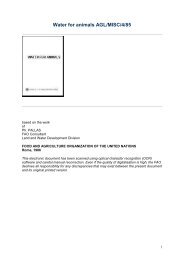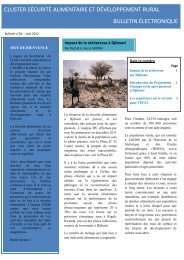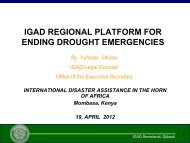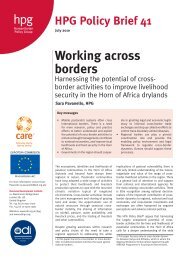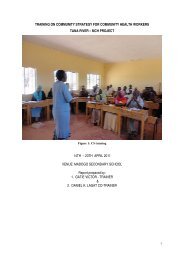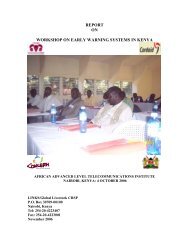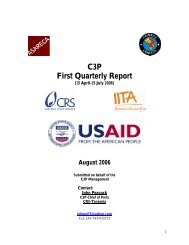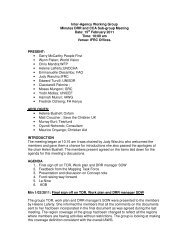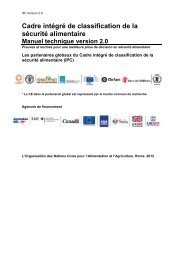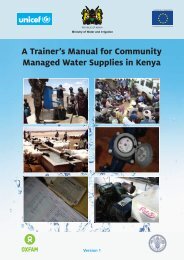Synthesis of Existing Knowledge and Experience on the Provision of ...
Synthesis of Existing Knowledge and Experience on the Provision of ...
Synthesis of Existing Knowledge and Experience on the Provision of ...
You also want an ePaper? Increase the reach of your titles
YUMPU automatically turns print PDFs into web optimized ePapers that Google loves.
Secti<strong>on</strong> 2. Overview <str<strong>on</strong>g>of</str<strong>on</strong>g> pastoralism <str<strong>on</strong>g>and</str<strong>on</strong>g> development in pastoralregi<strong>on</strong>s up to 19912.1 The mobile pastoral producti<strong>on</strong> system <str<strong>on</strong>g>and</str<strong>on</strong>g> customary natural resourcemanagementTable 1: Pastoralist <str<strong>on</strong>g>and</str<strong>on</strong>g> agro-pastoralist populati<strong>on</strong>s in selected regi<strong>on</strong>sSources: FDRE, 2007; PCDP II, 2008; Oromia Water Works Design <str<strong>on</strong>g>and</str<strong>on</strong>g> Supervisi<strong>on</strong> Enterprise,2009.Regi<strong>on</strong> Populati<strong>on</strong> Pastoral Agro-pastoralAfar 1.4 milli<strong>on</strong> 1.26 milli<strong>on</strong> 0.14 milli<strong>on</strong>Somali 4.4 milli<strong>on</strong> 3.74 milli<strong>on</strong> 0.66 milli<strong>on</strong> (includeso<strong>the</strong>r livelihood groups)Oromia 27 milli<strong>on</strong> 4.32 milli<strong>on</strong>Pastoral producti<strong>on</strong> remains <strong>the</strong> dominant l<str<strong>on</strong>g>and</str<strong>on</strong>g> use in Ethiopia’s lowl<str<strong>on</strong>g>and</str<strong>on</strong>g>s, which occur below 1500melevati<strong>on</strong> <str<strong>on</strong>g>and</str<strong>on</strong>g> c<strong>on</strong>stitute between 54% <str<strong>on</strong>g>and</str<strong>on</strong>g> 61% <str<strong>on</strong>g>of</str<strong>on</strong>g> <strong>the</strong> country’s surface area (Coppock, 1994;Oromia Water Works Design <str<strong>on</strong>g>and</str<strong>on</strong>g> Supervisi<strong>on</strong> Enterprise, 2009). Of <strong>the</strong> estimated 1.4 milli<strong>on</strong>people in Afar regi<strong>on</strong>, 90% are pastoralists 10 <str<strong>on</strong>g>and</str<strong>on</strong>g> 10% agro-pastoralists 11 while <str<strong>on</strong>g>of</str<strong>on</strong>g> Somali regi<strong>on</strong>’s 4.4milli<strong>on</strong> people, 85% are pastoralists, <str<strong>on</strong>g>and</str<strong>on</strong>g> <strong>the</strong> remainder a combinati<strong>on</strong> <str<strong>on</strong>g>of</str<strong>on</strong>g> agro-pastoralists, farmers<str<strong>on</strong>g>and</str<strong>on</strong>g> urban dwellers (FDRE, 2007; PCDP II, 2008). Pastoralists also represent a significant proporti<strong>on</strong><str<strong>on</strong>g>of</str<strong>on</strong>g> <strong>the</strong> populati<strong>on</strong> in Oromia <str<strong>on</strong>g>and</str<strong>on</strong>g> SNNPR’s arid lowl<str<strong>on</strong>g>and</str<strong>on</strong>g>s (PCDP II, 2008). To date, agriculturalproducti<strong>on</strong> is limited in many <str<strong>on</strong>g>of</str<strong>on</strong>g> <strong>the</strong> country’s pastoral regi<strong>on</strong>s. In Afar, <strong>on</strong>ly about 0.3% <str<strong>on</strong>g>of</str<strong>on</strong>g> <strong>the</strong> totall<str<strong>on</strong>g>and</str<strong>on</strong>g> area is used for crop farming <str<strong>on</strong>g>and</str<strong>on</strong>g> in Somali, 5.5% <str<strong>on</strong>g>of</str<strong>on</strong>g> <strong>the</strong> total l<str<strong>on</strong>g>and</str<strong>on</strong>g> area is used for mostly rainfed agriculture, <str<strong>on</strong>g>and</str<strong>on</strong>g> 0.2% for irrigati<strong>on</strong> (Ibid). However, crop producti<strong>on</strong> is becoming morewidespread in some parts. About 40% <str<strong>on</strong>g>of</str<strong>on</strong>g> Oromia regi<strong>on</strong> is c<strong>on</strong>sidered pastoral, where most <str<strong>on</strong>g>of</str<strong>on</strong>g> <strong>the</strong>l<str<strong>on</strong>g>and</str<strong>on</strong>g> cover c<strong>on</strong>stitutes rangel<str<strong>on</strong>g>and</str<strong>on</strong>g>s <str<strong>on</strong>g>and</str<strong>on</strong>g> about 5% is under cultivati<strong>on</strong> (Oromia Water Works Design<str<strong>on</strong>g>and</str<strong>on</strong>g> Supervisi<strong>on</strong> Enterprise, 2009). In parts <str<strong>on</strong>g>of</str<strong>on</strong>g> this regi<strong>on</strong>, however, where changing l<str<strong>on</strong>g>and</str<strong>on</strong>g> use ispredominant, a study has shown that in <strong>the</strong> late 1990s 16.3% <str<strong>on</strong>g>of</str<strong>on</strong>g> <strong>the</strong> total l<str<strong>on</strong>g>and</str<strong>on</strong>g> area <str<strong>on</strong>g>of</str<strong>on</strong>g> <strong>the</strong> study sitewas set aside for crop producti<strong>on</strong>, up from <strong>on</strong>ly 1.4% in 1986 (McCarthy et al, 2001). The extent <str<strong>on</strong>g>of</str<strong>on</strong>g>l<str<strong>on</strong>g>and</str<strong>on</strong>g> enclosed for grazing has also grown al<strong>on</strong>gside, with an additi<strong>on</strong>al 3.67% enclosed <str<strong>on</strong>g>and</str<strong>on</strong>g> privatized,indicating recent changes in property rights dynamics in some areas (ibid). Fur<strong>the</strong>rmore, whereas 30years ago <strong>on</strong>ly 10% <str<strong>on</strong>g>of</str<strong>on</strong>g> <strong>the</strong> study sample c<strong>on</strong>tained households who practiced cultivati<strong>on</strong>, by <strong>the</strong> late1990s about 80% <str<strong>on</strong>g>of</str<strong>on</strong>g> <strong>the</strong> sample included households engaged in crop producti<strong>on</strong> (ibid).10 C<strong>on</strong>sistently defined in various literature as people who obtain more than 50% <str<strong>on</strong>g>of</str<strong>on</strong>g> <strong>the</strong>ir income fromlivestock <str<strong>on</strong>g>and</str<strong>on</strong>g> livestock products. Pastoralists also characteristically practice mobility to avoid risk, resp<strong>on</strong>d tovariable climatic c<strong>on</strong>diti<strong>on</strong>s <str<strong>on</strong>g>and</str<strong>on</strong>g> ensure healthy livestock <str<strong>on</strong>g>and</str<strong>on</strong>g> rangel<str<strong>on</strong>g>and</str<strong>on</strong>g>s.11 C<strong>on</strong>sistently defined as people who obtain less than 50% <str<strong>on</strong>g>of</str<strong>on</strong>g> <strong>the</strong>ir income from livestock <str<strong>on</strong>g>and</str<strong>on</strong>g> livestockproducts, <str<strong>on</strong>g>and</str<strong>on</strong>g> most <str<strong>on</strong>g>of</str<strong>on</strong>g> <strong>the</strong> remaining income from cultivati<strong>on</strong>. Mobility is practiced but to a more limitedextent as compared to pastoralists.23



